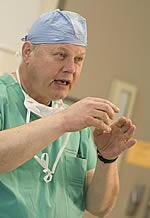ECU surgeon completes 400th robot-assisted mitral valve repair
Dr. W. Randolph Chitwood Jr. successfully performed his 400th robot-assisted mitral valve repair today. The surgeon has performed more of these surgeries than anyone else.
The operation took place at Pitt County Memorial Hospital, the teaching hospital of the Brody School of Medicine at East Carolina University, where Chitwood is a faculty member.
The patient was a 38-year-old man.

Chitwood
Eleven cardiac surgeons from across the county observed the historic procedure while attending a two-day training program. Chitwood’s robotics training center at ECU is the first site in the United States to offer formal training in robot-assisted mitral valve repair procedures.
“By integrating computer-enhanced technology with the surgeons’ technical skills, robotic-assisted procedures enable surgeons to perform better surgery in a manner never before experienced,” said Chitwood, president of the Society of Thoracic Surgeons, director of the East Carolina Heart Institute and professor of cardiovascular surgery at the Brody School of Medicine.
Chitwood is a pioneer in the development and expansion of mitral valve repair surgery, producing outcomes better than valve replacement, a once-prevalent surgical treatment for a leaky or narrowing mitral valve. An estimated 40,000 patients a year, many under the age of 50, have operations on their mitral valve, the inflow valve for the left side of the heart. More than 90 percent of these cases require a sternotomy, or cracking of the sternum, resulting in a 12-week recovery. With a robotic device there are only three small incisions, scaring is minimal, infection rate is lower and recovery time is lessened to two weeks.
“Not only is this technique far less invasive than traditional open-heart procedures, making it safer and far less painful for the patient, but repair of the valve, as opposed to replacement, has many additional benefits,” Chitwood said.
According to research cited in Sept. 28 article in U.S. News & World Report, “(M)ore than 90 percent of valve leaks can be successfully repaired. Compared with replacement, repair brings better heart function and less risk of infection, blood clots, and stroke. Patients live longer, too.”
This 400th operation signifies the future for robotic-assisted cardiac surgery as surgeons are learning to perform this complex mitral valve repair procedure through Chitwood’s training program. Typically, surgeons would replace a mitral valve with a mechanical device. These mechanical valves require lifelong dependence on blood-thinning medications, and some require additional replacement surgery approximately every 10 to 12 years.
In 1994, Chitwood began his pursuit to improve minimally invasive cardiac surgery and, specifically, the mitral valve repair procedure and did the first minimally invasive mitral valve repair in North America in 1996. Recognizing that endoscopic methods already used in surgery on other parts of the body could provide better visibility and access to the mitral valve, Chitwood devised a set of special instruments to simplify the repair procedure. The first totally endoscopic and robotic mitral valve repair in North America, and the second in the world, was completed by Chitwood in May 2000.
In 1999, Chitwood applied his endoscopic expertise to robotic technology and helped develop the da Vinci Surgical System, a $1.5 million robotic surgical device made by Intuitive Surgical of Sunnyvale, Calif. In 2000, Chitwood used the da Vinci system to perform the first complete robotic-assisted mitral valve repair in North America as part of a multi-center, FDA-approved trial. In November 2002, the FDA approved the robotic-assisted mitral valve repair procedure. Since then, many mitral valve repairs with the da Vinci have taken place around the world.